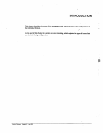
10.1
UNDERSTANDING THE DTMFINT TABLE
The DTMFXNT Table interprets an incoming D’ThIF &I record by identifying the type of call,
matching it with a suitable call action by the Toshiba VP System, and collecting the Called and
cal.lingPartyID.
Since each individual PBX manufacturer sends proprietary DTMF codes to identi$call types, and
further, will send the various items of information in the order they choose, the DTMFINT Table
is very flexible to accommodate the great variety of call record formats encountered.
The Toshiba VP System configures a default DTMFINT
Table for a specific PBX model when
System Parameter 3 - PBX TYPE is modified. Selecting and configuring the default DTMFINT
Table is independent of selecting default PBX system parameters. Therefore, the detailed
configuration information contained in this section is usually used to modify a default table.
The key to understanding the DTMFfNT Table is to recognize that the order of elements in a call
record format specified by the PBX manufacturer is the pattern that the DTMFINT Table must
reproduce. The string of DTMF digits sent by the PBX to the Toshiba VP System contains some
or all of the following items:
l
Call typecode
= Calling party ID
0 Miscellaneous field separators
Configuring the DTMFINT Table requires identifying all the possible call record formats (20
maximum) that will be sent as DTMF digits and making entries in the DTMFINT Table to match
them. The types of calls that a particular PBX can support depends on the PBX’s own
capabilities.
The first set of DTMF digits in a call record is the call type code which is a fiied DTMF digit
string and must be unique. For each unique call type, a Toshiba VP System call action is assigned
that determines which prompt the system plays and action it takes. The system interprets the
remaining DTMF digits in a call record according to the specific call record type.
The following is an example of a DTMFINT Table.


















